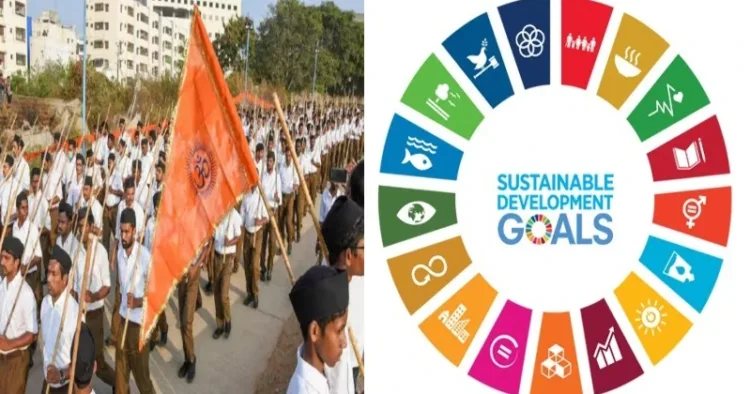For decades, the world’s economic stage has been controlled by two main models: China’s Communist system and the Western world’s Capitalist approach. These two giants have greatly influenced how economies worldwide operate. However, despite their dominance, the outcome is glaringly clear i.e. we live in a less equitable world. The continuous push and want for economic growth driven by the desire for more stuff, especially started by Western countries and followed by others has resulted in consuming natural resources too quickly. This has caused serious problems like climate change, which now threatens life on Earth. These issues have become even more obvious since the COVID-19 pandemic and thus highlight the need for new ways of doing economics.
Thus, India, with its unique socio-economic structure offers a promising alternative through a Bharat-centric model. This model, advocated by intellectuals and dedicated volunteers of the Rashtriya Swayamsevak Sangh (RSS) since the 1960s, emphasizes sustainable and equitable development that fits India’s particular circumstances. The Rashtriya Swayamsevak Sangh (RSS) has actively involved itself in various aspects of the economy, including economics, trade unions, microfinance, rural development, and environmental protection. This multi-faceted engagement has facilitated a thorough and holistic evolution of the Bharat-centric model. India’s adoption of a Bharat-centric model introduces a refreshing diversity to the global economic panorama. By placing emphasis on decentralized, community-led economic growth, India presents an alternative trajectory distinct from the conventional Western and Chinese paradigms.
History of Bharat-Centric Model/ Third Way
Dattopant Thengadi, a prominent figure in the Rashtriya Swayamsevak Sangh (RSS) and the founder of various organizations like Swadeshi Jagaran Manch (SJM), Bharatiya Mazdoor Sangh (BMS), and Bharatiya Kisan Sangh (BKS), coined the term “Third Way” to describe this model. He believed in a unique approach that combined elements from different economic ideologies. Another influential RSS leader, Deendayal Upadhyay, expanded on this concept through his lectures on Integral Humanism in 1964. This philosophy emphasizes on the integral development of individuals and society and was embraced by political parties like the Bharatiya Jana Sangh (BJS) and later, its successor, the Bharatiya Janata Party (BJP). It forms the ideological bedrock for a holistic economic framework.
In March 2022, the RSS passed a resolution outlining an updated version of this Bharat-centric economic model. With its wealth of natural resources, expansive labor force, and inherent entrepreneurial spirit, Bharat (India) has the potential to revolutionize its key sectors such as agriculture, manufacturing, and services. This transformation holds the promise of generating plentiful job prospects and propelling the economy to unprecedented levels of prosperity.
The Bharatiya economic model places a strong emphasis on human well-being, focusing on labor-intensive methods that are mindful of the environment. It promotes decentralization, ensuring that benefits are fairly distributed across communities. This approach revitalises the village economy and supports small-scale industries, particularly in agriculture. Moreover, there’s a concerted effort to enhance employment opportunities in rural areas, including the unorganized sector, and to encourage greater participation of women in economic activities. By embracing the Bharat-centric model, India enhances its standing in global trade and economic alliances. This approach prioritizes self-reliance and sustainable practices, making India an attractive partner for international collaborations. With a focus on ethical and equitable economic development, India becomes a trusted player in the global marketplace, fostering stronger relationships with other nations and contributing to mutual prosperity.
To keep up with the fast-changing global economy and technology, India needs to come up with new and creative ways of doing things. It’s also important to explore job opportunities in digital technology and selling goods to other countries. This means providing training before people start their jobs and helping them learn new skills while they work. Research and coming up with new ideas, as well as supporting businesses that are environmentally friendly, are also key parts of this.
The resolution put forth by the RSS urges individuals to embrace and promote Bharat-centric approaches to creating employment opportunities. It emphasises the importance of strengthening the economy and fostering sustainable, comprehensive development. Encouraging citizens from all sectors of society to cultivate a positive work culture grounded in timeless values, the resolution aims to ignite efforts that facilitate a wide range of employment opportunities. This collective initiative is envisioned as a means for India to reassert its significant role in the global economic landscape.
India is paving the way towards a greener future through its dedication to environmentally friendly practices like organic farming, embracing renewable energy, and reducing waste. This commitment positions India as a frontrunner in the global sustainability movement, setting an example for others to follow.
The Bharat-centric model is helping India become more competitive in the fast-changing digital world by supporting new ideas and businesses. With lots of new companies starting up, a youthful and tech-savvy workforce, and government initiatives aimed at nurturing innovation and bolstering digital infrastructure, India is emerging as a hub for groundbreaking technological advancements. This positions India as a key player in shaping the future of global industries such as artificial intelligence, blockchain, and fintech.
In conclusion, the Bharat-centric model offers a sustainable, equitable alternative to the existing global economic paradigms. By leveraging local strengths, fostering entrepreneurship, and prioritizing eco-friendly and human-centric practices, India can lead the way towards a more balanced and resilient economic future. This model isn’t just beneficial for India’s own growth, but it also elevates its significance and impact on the world stage. Through a focus on sustainability, inclusivity, innovation, and cultural exchange, India emerges as a guiding light in an ever-changing world, playing a pivotal role in fostering a more harmonious, resilient, and prosperous global economy.



















Comments